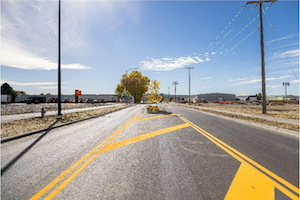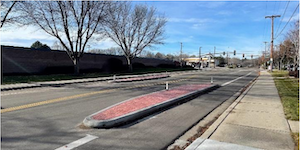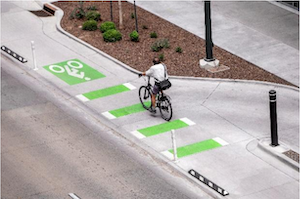Prioritizing safety and committing to the SSA framework can make a big impact in the effort to reduce traffic fatalities.

After an alarming increase in 2021 and 2022, traffic fatalities in the U.S. have fallen for nine consecutive quarters, according to the latest count from the National Highway Traffic Safety Administration. One key to this success is the ongoing adoption of Safe System Approach (SSA) principles by cities and states.
The increased effort by the U.S. Department of Transportation to champion the SSA as a best practice — highlighted in the National Roadway Safety Strategy in 2022 — has led to more engineers and planners embracing its principles. Simply put, the SSA recognizes that humans are vulnerable and make mistakes; therefore, speeds and conflicts must be managed so that people do not die on our roads because of human error.
The SSA envisions a system with redundant layers of protection that minimize the likelihood and severity of crashes. This principles-based approach asks planners and engineers to consider safety for all modes across the project development process. At each stage of policy-setting, planning or project development, practitioners can proactively consider how to identify and address transportation safety risks, design for human mistakes and limitations, and, in the event of a crash, reduce the potential severity of the crash.
A Safe Systems Approach starts with small, meaningful steps
Implementing the SSA and developing a transportation system to reduce fatalities and serious injuries is no small task. However, there are steps that every agency or practitioner can take to begin making a difference today.
The five elements of the SSA — safe roads, safe speeds, safe users, safe vehicles, and post-crash care — can be used as a framework for considering safety in any stage of planning, designing or implementation of a safer transportation system.
Element 1: Safe roads
It’s important to examine every detail in the transportation environment that could contribute to safer roads. Agencies can start small. During the development of the Minnesota Department of Transportation’s County Roadway Safety Plans, for example, a systemic analysis identified high-priority locations for small, low-cost improvements across the entire road network, focusing on implementing proven safety countermeasures. Some simple safe road ideas for consideration are:

- Increase sight distance at intersections by trimming roadside vegetation and prohibiting parking near corners.
- Update retro reflectivity, restripe roads with wider lines and more durable and retro-reflective pavement marking material, and increase the size of street signs.
- Add rumble strips to road resurfacing projects to reduce lane departure crashes.
- Install median islands and barriers to reduce and eliminate cross-over crashes and reduce the number of crossing conflicts at driveways.
- Restripe roadways to repurpose excess vehicle lanes to add left-turn lanes and create separated and protected bicycle facilities where feasible.
- Enhance lighting standards to consider streetlights in urban areas and at rural intersections, especially where pedestrian crashes are occurring.
Element 2: Safe speeds
As we recognize human vulnerabilities, we know that reducing kinetic energy imposed on the human body during a crash is essential to preventing severe or fatal crashes. Managing speeds is the most effective way of controlling this kinetic energy. Some simple safe speed ideas for consideration are:

- Increase the number of speed limit signs and consider vehicle speed feedback signs to increase driver awareness and encourage safer driving behaviors. The city of Seattle found that by lowering speed limits and posting speed limit signs more frequently, vehicle speeds and severe crashes declined without any additional enforcement, traffic calming, or roadway geometry changes.
- Install traffic calming measures like curb extensions, medians, and pedestrian refuge islands, or lane reductions to slow traffic and provide space for pedestrians or cyclists.
- Design new roads with a target travel speed, while also incorporating features for the expected mix of vehicles, cyclists, and pedestrians.
- Utilize speed safety camera enforcement, which has been shown to be effective in curbing speeding where deployed. Automated speed enforcement is legal in nearly half of U.S. states, with two of the most populous — Florida and California — piloting its expanded use.
Element 3: Safe users
It’s important that all roadway users are considered and that the promotion of safe behaviors from drivers, pedestrians, and bicyclists is prioritized. Some simple safe user ideas for consideration include:

- Increase public engagement and education efforts and consider developing and implementing local Vision Zero and Toward Zero Death programs.
- Focus on the “big three” risk behaviors of speeding, not wearing seatbelts, and impaired driving.
- Focus public engagement strategies on shared responsibility for safety and avoid blaming or shaming people involved in crashes.
- Provide data to law enforcement agencies and prosecutors to help them better direct their efforts toward improving specific traffic safety outcomes.
- Engage with community public health agencies and other partners to better understand the needs and socioeconomic demographics of your community.
- Develop education campaigns for school children to bring home the safety message to their families.
Element 4: Safe vehicles
In any crash involving a vehicle, the first layer of defense for the driver and passengers is their vehicle. The type of vehicle is a factor in whether a pedestrian or cyclist is more likely to be injured or killed. To improve road safety, it is important to not only focus on infrastructure but also on vehicle safety. Consider some simple safe vehicle ideas, like:
- Encourage the adoption of driver assisted technologies such as lane assist, back-up cameras, blind spot detectors, and emergency braking.
- Lead by example by regularly reviewing and updating vehicle fleet and rental car policies to incorporate the latest safety technology.
Element 5: Post-crash care
When crashes do occur, the post-crash care response is the final element working to prevent a serious injury from becoming a fatality. Some simple post-crash care ideas include:
- Participate in or develop state and local traffic incident management (TIM) programs, like those in New Jersey, Nebraska, Minnesota and Nevada.
- Implement the latest in intelligent transportation systems, a critical component of an effective TIM program, such as traffic cameras and ramp metering to aid in the emergency response efforts during a traffic incident.
- Establish preplanned diversion routes on major roads within a district to be better prepared when a roadway is closed to protect road users and emergency responders on scene at a traffic incident.
- Collaborate with local emergency medical service providers to understand their strengths, weaknesses, operations, and barriers to identify ways to support EMS efforts and improve response times and outcomes for crash victims.
… And work toward big, bold ideas
The paradigm shift of the SSA framework requires different thinking, different priorities, and different decisions. It encourages infrastructure owners and designers to reflect on whether the policies, plans, and projects they are working on consider all transportation modes and provide features that focus on saving lives and reducing serious injuries.
With some of the small steps underway, there are also big and bold ideas that can save lives in our transportation system:
- Recognize that all communities deserve a safe and easy-to-use transportation system. Look at neighborhoods in your community and identify opportunities to improve safety for all modes of transportation.
- Consider every project to be a transportation safety project and integrate safety features for all modes from the outset of the project. Strive to provide safe mobility for all users.
- Manage vehicle speeds to the surrounding land use context using infrastructure and enforcement (automated or police patrols).
- Consider policy changes that direct how intersection control is prioritized, evaluated, and selected (e.g., intersection control evaluation policies). Roundabouts significantly reduce fatal and serious injury crashes at intersections; an intersection control evaluation policy would, at minimum, require planners and engineers to consider roundabouts on a given intersection modification project.
- Advocate for laws that have a proven benefit, like primary enforcement seatbelt laws, speed safety cameras, driver impairment laws, or driver distraction laws.
- Consider prohibiting left turns for motorists at intersections in downtown pedestrian-oriented environments.
Developing your tailored Safe System Approach
In the U.S., long-term commitment to Vision Zero and the SSA is delivering success. Two early-adopters — New York City and Columbia, Missouri — have recorded 25 percent and 42 percent reductions in fatal crashes respectively over the last decade, according to NHTSA statistics. Other cities, including Honolulu; Bellevue, Washington; and Boise, Idaho have reported similar results through SSA-aligned programs. Hoboken, New Jersey, reached its goal of zero deadly crashes in 2017 and hasn’t recorded any traffic deaths since. These successes came at a time when fatal crashes across the U.S. increased by 30 percent.
If you don’t have an SSA-aligned community transportation safety plan, consider developing one. A comprehensive safety action plan provides an opportunity to engage the public and elected officials on the urgency of the safety crisis. Outreach efforts can build champions and stakeholder support through meaningful conversations and avoid push-back against safety interventions. They also represent the opportunity to forge new partnerships with peer agencies.
Think about the organizations, groups, or departments that you can build strong relationships with to support SSA principles and implementation efforts. If you already have a transportation safety plan, consider whether it is time to update the plan to integrate SSA concepts. Either way, the good news is that the USDOT Safe Streets and Roads for All (SS4A) grant program offers funding of up to 80 percent of the cost of a safety action plan and other related planning and demonstration activities.
Commit today to achieve lasting change
While the task of improving road safety may seem overwhelming, incremental changes add up to create a noticeable and life-saving impact on the transportation network. You won’t be able to change the entire system, policies, or legislation right away, but you can begin by incorporating the principles and elements of the SSA into every transportation project you work on, regardless of the scale or type. For each policy, plan or project you are working on, ask yourself whether all the SSA elements have been considered. If they have not, think about how you can address or strengthen them and who you can collaborate with on any issues that might arise. By applying these considerations, meaningful improvements in road safety can be achieved over time to create lasting change.
Beth Wemple, P.E., RSP, is a senior transportation safety engineer at HDR. Jay Aber, P.E., PTOE is a senior traffic engineer at HDR. Olivia Polinsky-Rose is a traffic engineer at HDR. Together, the three have more than 60 years of experience in traffic and road safety projects.

Planetizen Federal Action Tracker
A weekly monitor of how Trump’s orders and actions are impacting planners and planning in America.

Chicago’s Ghost Rails
Just beneath the surface of the modern city lie the remnants of its expansive early 20th-century streetcar system.

Amtrak Cutting Jobs, Funding to High-Speed Rail
The agency plans to cut 10 percent of its workforce and has confirmed it will not fund new high-speed rail projects.

Ohio Forces Data Centers to Prepay for Power
Utilities are calling on states to hold data center operators responsible for new energy demands to prevent leaving consumers on the hook for their bills.

MARTA CEO Steps Down Amid Citizenship Concerns
MARTA’s board announced Thursday that its chief, who is from Canada, is resigning due to questions about his immigration status.

Silicon Valley ‘Bike Superhighway’ Awarded $14M State Grant
A Caltrans grant brings the 10-mile Central Bikeway project connecting Santa Clara and East San Jose closer to fruition.
Urban Design for Planners 1: Software Tools
This six-course series explores essential urban design concepts using open source software and equips planners with the tools they need to participate fully in the urban design process.
Planning for Universal Design
Learn the tools for implementing Universal Design in planning regulations.
Caltrans
City of Fort Worth
Mpact (founded as Rail~Volution)
City of Camden Redevelopment Agency
City of Astoria
City of Portland
City of Laramie





























